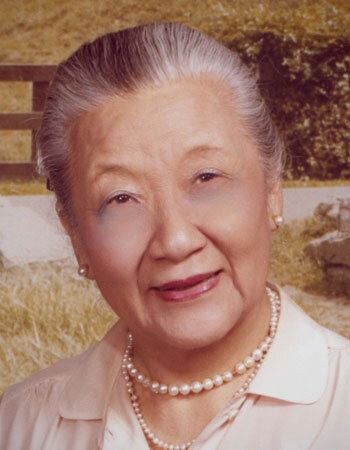Snapshot: Ted and Rose Wu and Tai Shan Restaurant
The brightly-painted Art Moderne building at 2603 Broadway, currently home of the Fiesta San Antonio Commission, was built in 1946 as Tai Shan Restaurant for Ted and Rose Wu. The Wus were more than successful restauranteurs; though neither were Texans by birth, they worked throughout their lives to support Chinese Americans, their community, and their businesses in San Antonio.
An illustrated postcard for Tai Shan Restaurant, courtesy of ebay.com.
Chinese people were the first Asian immigrants to settle in Texas, arriving in 1870 to build a railroad from Calvert to the Brazos River Valley. The next decade, 2,600 additional Chinese people moved to Texas from California to work on the Southern Pacific line to El Paso. In the early 1900s, Chinese people previously living and working in Mexico moved to Texas, and some chose to remain in Bexar County, which at the time had the state’s largest Chinese population at well over 300. These more recent immigrants, more familiar with the Spanish language than English, settled in the downtown neighborhood known as Laredito, west of San Pedro Creek. The On Leong Merchants Association was located on Laredo Street through the 1930s. By 1940, San Antonio’s Chinese population had grown to 600 people.
Tai Shan Restaurant opened October 24, 1946, under the management of Ted Wu and boasted room enough for 275 patrons “with plenty of parking space on the side of the building with entrance on the side.” The restaurant served both Chinese and American food, the former prepared “by a chef that formerly worked in New York’s Chinatown and is regarded as one of the finest Chinese chefs in the United States.” The caption on a photo of the restaurant calls it “one of the most modernistic buildings in the southwest.” Tai Shan was one of a number of Chinese American-owned restaurants and businesses along the Broadway corridor, including (but not limited to) the New Crystal Café at 518 Broadway, Chinese Village at 1705 Broadway, King’s Palace at 3304 Broadway, and Hung Fong at 3624 Broadway.
Ted Wu pictured in 1936. San Antonio Express, Friday morning, 3 April 1936, p. 18.
Ted Wu was born in Berkley, California, in 1898, and didn’t move to San Antonio until 1930. He was a fixture of the Chinese and Chinese-descent community in San Antonio long before he opened Tai Shan. Ted taught at the Chinese school in the 1920s, a space created by and for the community. He had a grocery store in the area now home to HemisFair and was a co-founder of Boysville, a youth home that opened in 1942. He was director of the Kuomintang Survivors, a group dedicated to support of those impacted by the 1927 Shanghai Massacre, also known as the April 12 Purge or the April 12 Incident, in which members of the Communist Party of China were violently suppressed, resulting in as many as 5,000 deaths. He was chairman of the San Antonio’s On Leong Chinese Merchants’ Association and a founding member of the Chinese American Citizens Alliance in San Antonio. His obituary begins by calling him “one of the area’s most prominent businessmen.”
Prior to opening Tai Shan, Ted pursued another venture in Brackenridge Park. In June 1942, in the aftermath of the December 1941 attack on Pearl Harbor and falling in line with nationwide anti-Japanese policies, San Antonio Fire and Police Commissioner P.L. Anderson introduced a resolution to change the name of the Japanese Sunken Garden to the Chinese Garden. “San Antonio should be rid entirely of [Japanese] influences,” Anderson said, and the City Council agreed, officially changing the name on June 23, 1942. The following month, the city requested bids for operation of the tea house at the gardens. On July 30, 1942, Ted Wu bid “for the privilege of operating the concession at the Chinese Garden;” his bid was accepted and a lease signed to begin August 1, 1942. The new lease ended the 25-year management of the tea house and gardens by the Jingu family, who were Japanese-American and had until then been the tea house’s first and only occupants. The original name of the sunken gardens wasn’t restored until 1983.
Rose Wu, courtesy of Chinese American Exclusion/Inclusion.
After Ted’s death in 1961, Rose Wu was willed and took over management of Tai Shan. Rose, who was born in Tucson, Arizona, had her own history of advocating for the Chinese and Chinese-descent community. In 1937, white owners of grocery stores in Texas felt competition from Chinese-owned stores and sponsored a bill banning Chinese Americans from owning property in the United States. Rose testified against the bill in the Texas Senate, reminding representatives, “I am an American citizen. My grandfather helped to build the Southern Pacific Railroad through Texas. Twelve hundred Chinese helped build the railroad, and now there are only 700 Chinese in Texas...Everyone can tell I am Chinese by my color...all do not know that I am a citizen.” The bill was struck down due in part to her powerful testimony.
The Wu family retained ownership of the property at 2603 Broadway until 1988, when they sold it to Lawrence Bertetti. In 1999, Bertetti sold the property to its current owner and occupant, the Fiesta San Antonio Commission.
See more photos of the restaurant, Rose, and Ted by scrolling through the carousel below. To learn more about the Chinese and Chinese American experience in Texas, ScoutSA suggests reading Edward C. M. Chen’s article An American Chinese in Houston.
ScoutSA learned about Ted and Rose Wu’s contributions to our city as part of an Historic Assessment prepared for the Fiesta San Antonio Commission.













